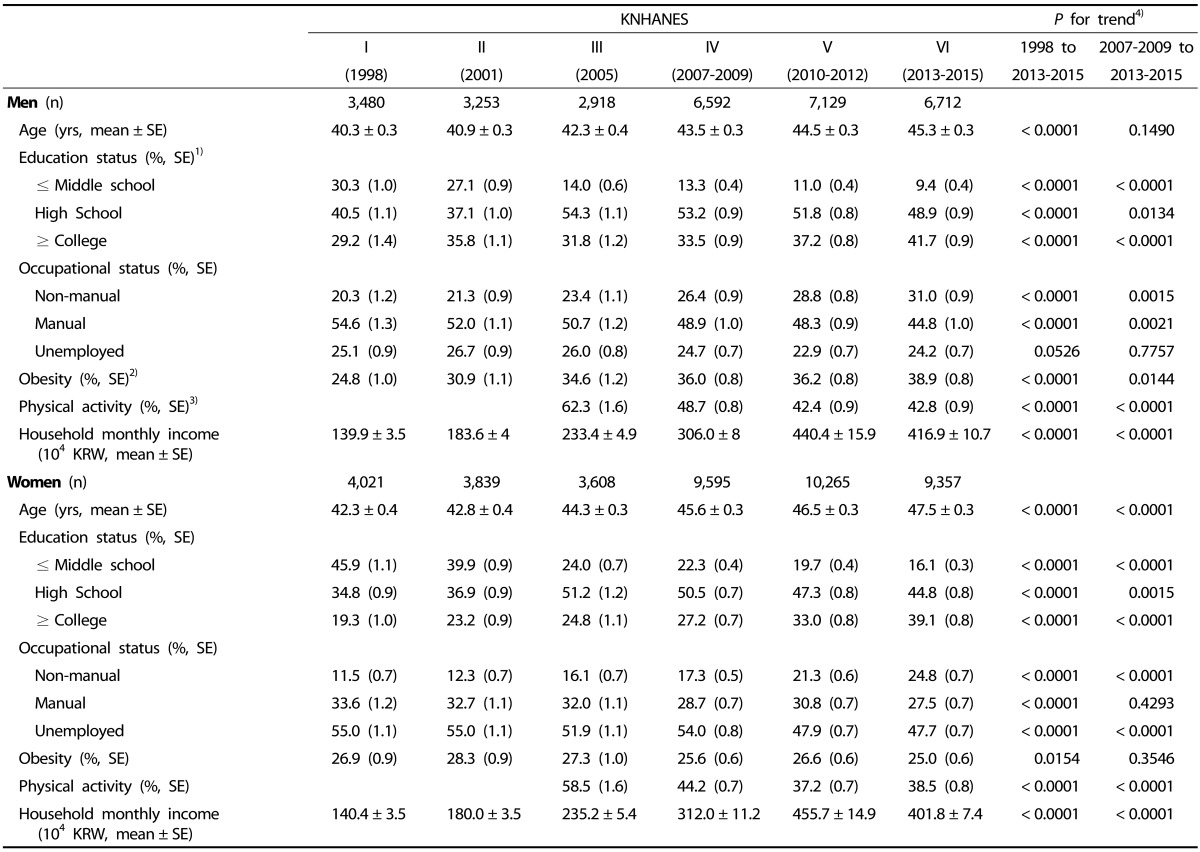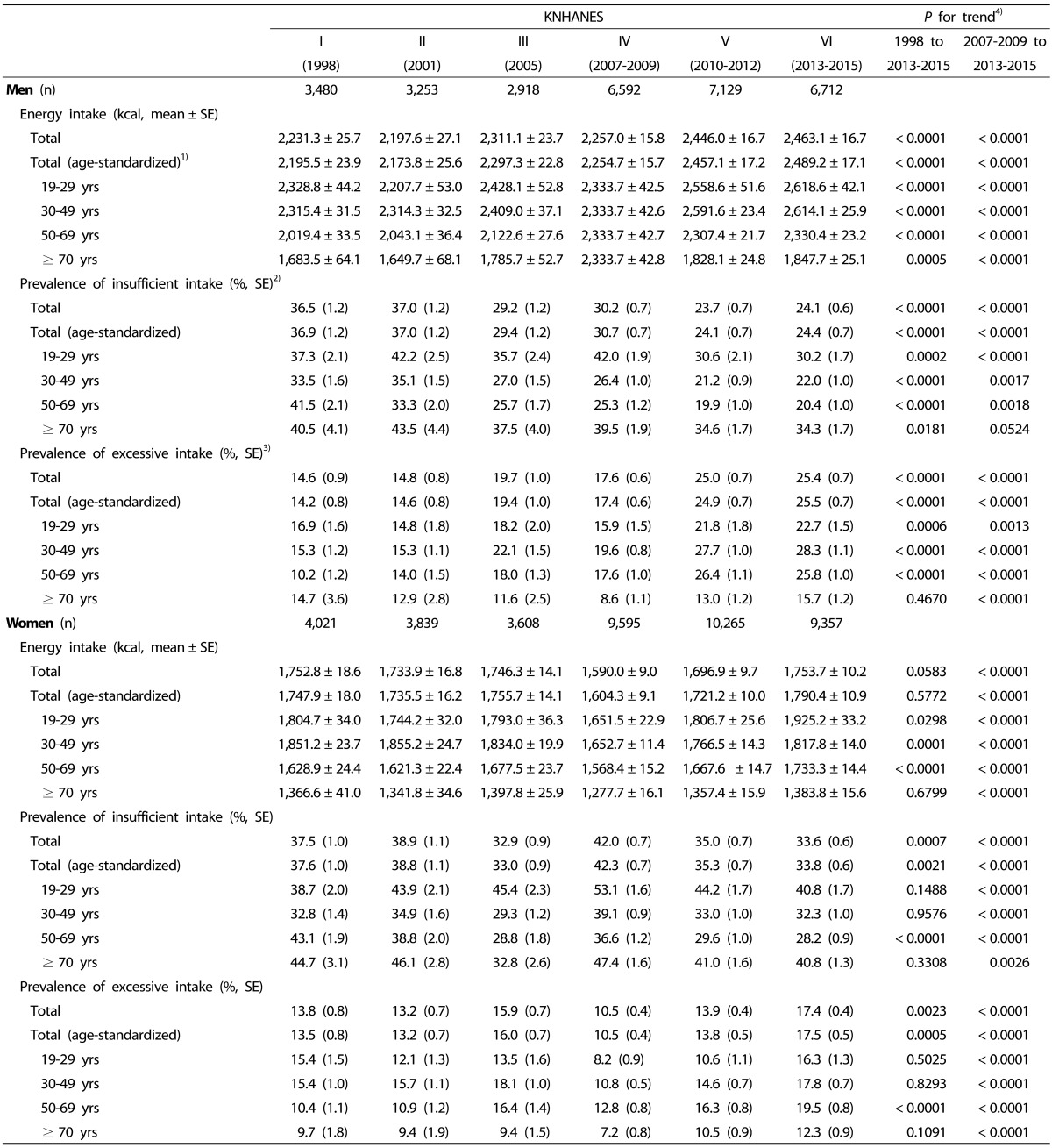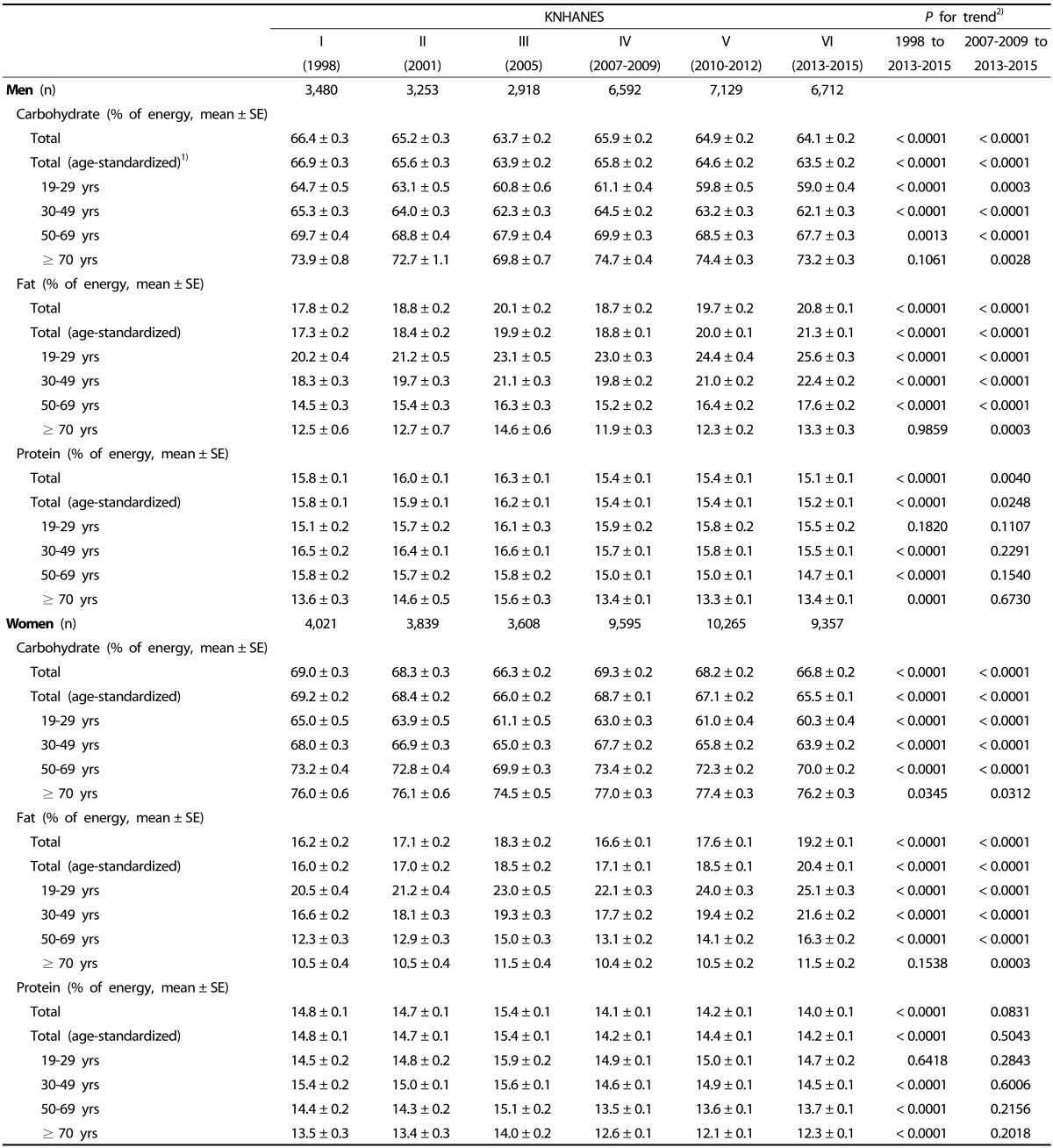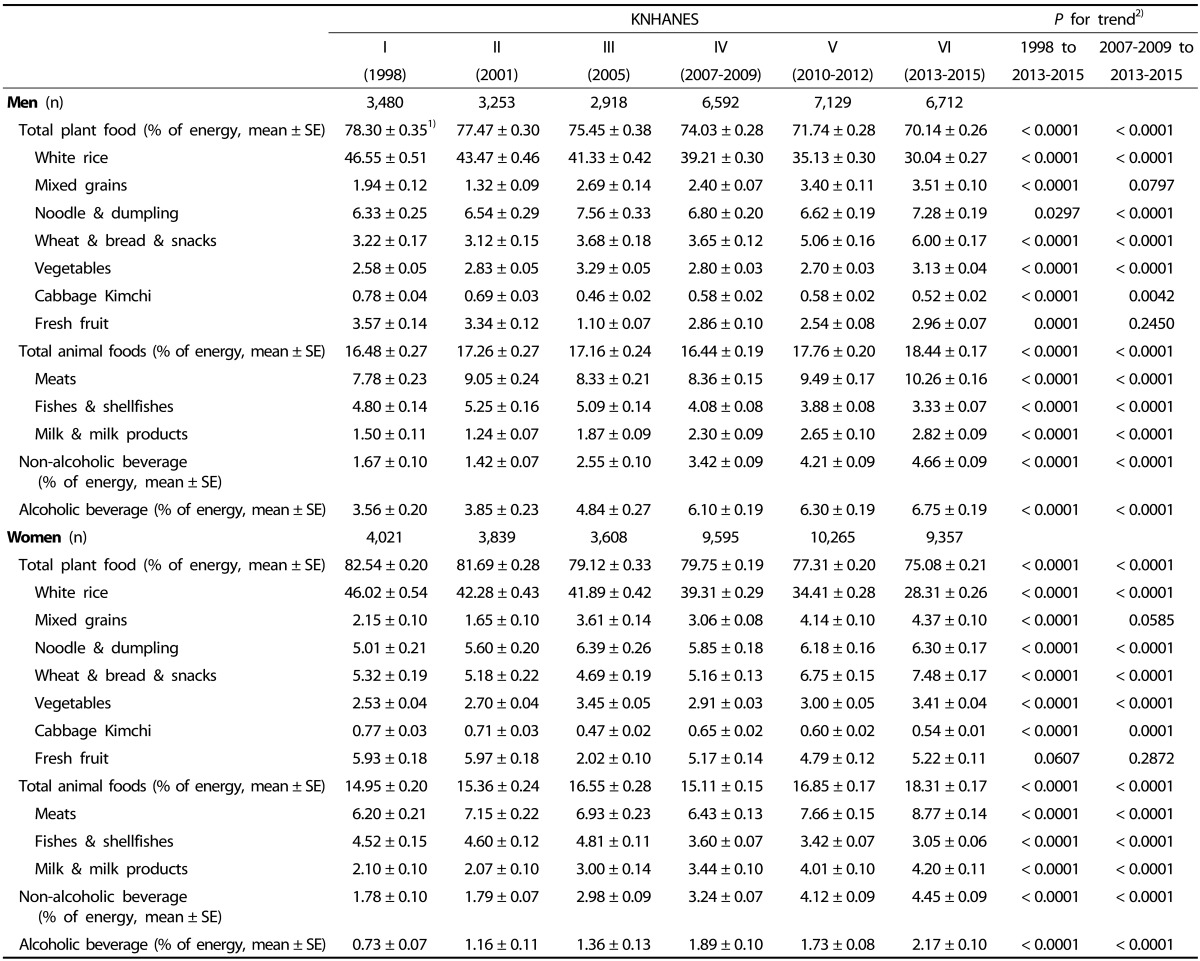3. Popkin BM, Adair LS, Ng SW. Global nutrition transition and the pandemic of obesity in developing countries. Nutr Rev. 2012; 70:3–21. PMID:
22221213.

4. Ford ES, Dietz WH. Trends in energy intake among adults in the United States: findings from NHANES. Am J Clin Nutr. 2013; 97:848–853. PMID:
23426032.
5. Whitton C, Nicholson SK, Roberts C, Prynne CJ, Pot GK, Olson A, Fitt E, Cole D, Teucher B, Bates B, Henderson H, Pigott S, Deverill C, Swan G, Stephen AM. National Diet and Nutrition Survey: UK food consumption and nutrient intakes from the first year of the rolling programme and comparisons with previous surveys. Br J Nutr. 2011; 106:1899–1914. PMID:
21736781.

6. Tada N, Maruyama C, Koba S, Tanaka H, Birou S, Teramoto T, Sasaki J. Japanese dietary lifestyle and cardiovascular disease. J Atheroscler Thromb. 2011; 18:723–734. PMID:
21685707.

7. Zhai F, Wang H, Du S, He Y, Wang Z, Ge K, Popkin BM. Lifespan nutrition and changing socio-economic conditions in China. Asia Pac J Clin Nutr. 2007; 16(Suppl 1):374–382. PMID:
17392135.
8. Flood VM, Burlutsky G, Webb KL, Wang JJ, Smith WT, Mitchell P. Food and nutrient consumption trends in older Australians: a 10-year cohort study. Eur J Clin Nutr. 2010; 64:603–613. PMID:
20234384.

9. Ministry of Health and Welfare, Korea Centers for Disease Control and Prevention. Korea Health Statistics 2015: Korea National Health and Nutrition Examination Survey (KNHANES VI-3). Sejong: Korea Centers for Disease Control and Prevention;2016.
10. Swinburn BA, Caterson I, Seidell JC, James WP. Diet, nutrition and the prevention of excess weight gain and obesity. Public Health Nutr. 2004; 7:123–146. PMID:
14972057.
11. Kim S, Moon S, Popkin BM. The nutrition transition in South Korea. Am J Clin Nutr. 2000; 71:44–53. PMID:
10617945.

12. Sook M. Food consumption trends and nutrition transition in Korea. Malays J Nutr. 2003; 9:7–17. PMID:
22692528.
13. Kweon S, Kim Y, Jang MJ, Kim Y, Kim K, Choi S, Chun C, Khang YH, Oh K. Data resource profile: the Korea National Health and Nutrition Examination Survey (KNHANES). Int J Epidemiol. 2014; 43:69–77. PMID:
24585853.

14. World Health Organization Western Pacific Region. International Association for the Study of Obesity. International Obesity Task Force. The Asia-Pacific Perspective: Redefining Obesity and Its Treatment. Sydney: Health Communications Australia Pty Limited;2000. p. 18.
15. Rural Development Administration, National Rural Living Science Institute (KR). Food Composition Table. 5th rev. ed. Suwon: Rural Development Administration, National Rural Living Science Institute;1996.
16. Rural Development Administration, National Rural Living Science Institute (KR). Food Composition Table. 6th rev. ed. Suwon: Rural Development Administration, National Rural Living Science Institute;2001.
17. Rural Development Administration, Rural Resource Development Institute (KR). Food Composition Table. 7th rev. ed. Suwon: Rural Development Administration, Rural Resource Development Institute;2006.
18. Rural Development Administration, National Institute of Agriculatural Sciences (KR). Standard Food Composition Table. 8th rev.ed. Suwon: Rural development Administration, National Institute of Agriculatural Sciences;2012.
19. The Korean Nutrition Society. Recommended Dietary Allowances for Koreans. 6th rev. ed. Seoul: The Korean Nutrition Society;1995.
20. The Korean Nutrition Society. Recommended Dietary Allowances for Koreans. 7th rev. ed. Seoul: The Korean Nutrition Society;2000.
21. The Korean Nutrition Society. Dietary Reference Intakes for Koreans. Seoul: The Korean Nutrition Society;2005.
22. The Korean Nutrition Society. Dietary Reference Intakes for Koreans. 1th rev. ed. Seoul: The Korean Nutrition Society;2010.
23. Kim HJ, Kim Y, Cho Y, Jun B, Oh KW. Trends in the prevalence of major cardiovascular disease risk factors among Korean adults: results from the Korea National Health and Nutrition Examination Survey, 1998-2012. Int J Cardiol. 2014; 174:64–72. PMID:
24742812.

24. Rhee SY, Park SW, Kim DJ, Woo J. Gender disparity in the secular trends for obesity prevalence in Korea: analyses based on the KNHANES 1998-2009. Korean J Intern Med. 2013; 28:29–34. PMID:
23345994.

25. Lim H, Kim SY, Wang Y, Lee SJ, Oh K, Sohn CY, Moon YM, Jee SH. Preservation of a traditional Korean dietary pattern and emergence of a fruit and dairy dietary pattern among adults in South Korea: secular transitions in dietary patterns of a prospective study from 1998 to 2010. Nutr Res. 2014; 34:760–770. PMID:
25262419.

26. Jang HB, Lee HY, Han YH, Song J, Kim KN, Hyun T. Changes in food and nutrient intakes of college students between 1999 and 2009. Korean J Community Nutr. 2011; 16:324–336.

31. Kwon YS, Ju SY. Trends in nutrient intakes and consumption while eating-out among Korean adults based on Korea National Health and Nutrition Examination Survey (1998-2012) data. Nutr Res Pract. 2014; 8:670–678. PMID:
25489407.

32. Gombi-Vaca MF, Sichieri R, Verly-Jr E. Caloric compensation for sugar-sweetened beverages in meals: a population-based study in Brazil. Appetite. 2016; 98:67–73. PMID:
26708263.

33. Park YS, Han JL, Kim SK, Kim C. Caloric intake to fat or alcoholic drink intake in middle-aged men is highly co-related than those in young men. J Korean Soc Food Sci Nutr. 2004; 33:679–686.








 PDF
PDF ePub
ePub Citation
Citation Print
Print


 XML Download
XML Download